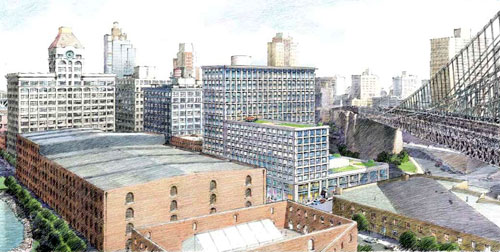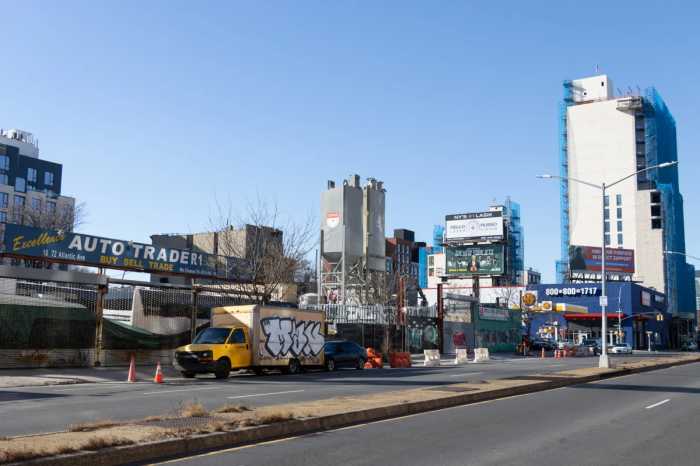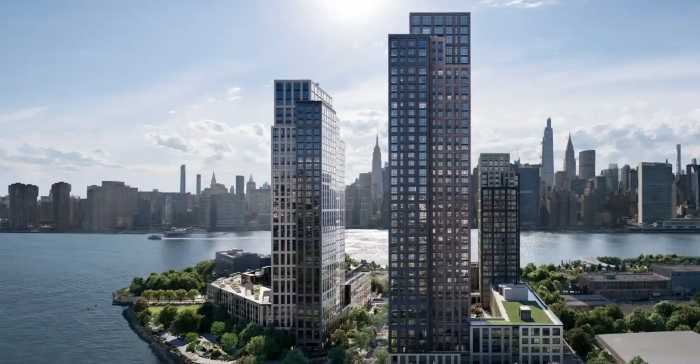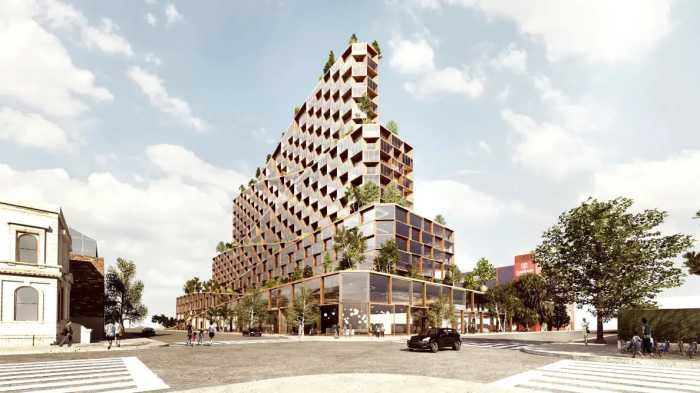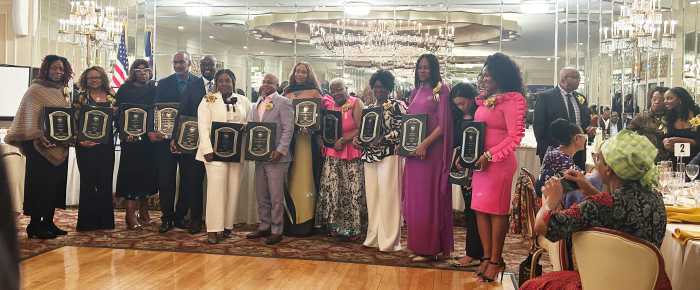Opponents of a controversial 18-story residential building and public middle school rallied on Sunday morning in hopes of blocking a building that they say will forever block views of the historic Brooklyn Bridge.
The four-dozen protesters said they do not oppose DUMBO developers Jed and David Walentases’ right to build on the site, which is under the fabled span between Front and Water streets — they just don’t want a building that will reach 183 feet.
“We’re not saying ‘no building,’ — we’re saying, ‘appropriate building,’” said DUMBO Neighborhood Association President Sheryl Buchholtz, whose group backed a recent Community Board 2 resolution capping any building on the site to 75 feet.
Her group’s development committee chair Christopher Tancredi added that the Association is in favor of development, “but in a respective manner.”
Tancredi dismissed the Walentases’ claim that the project’s public benefits — namely, a new middle school, 65 units of below-market-rate housing, and a certified “green” design — cannot be achieved in such a small building.
“We think [the public benefits] can be achieved … [with a building] with no height above the bridge,” he said.

The rally came three days before the full Community Board 2 will vote on the project on Jan. 14. Last month, Community Board 2’s land-use committee voted 7-6 against the project, a vote that is the first step in a seven-month public review process required whenever a developer seeks a rezoning.
The Walentases need a rezoning so that their building can include residential units — and a middle school that could save the city $50 million in development costs. Under current zoning, the Walentases could actually build a taller building right now, though such a structure would not be as profitable.
The public review process will eventually bring the proposal to the City Council, where members tend to defer to the local councilmember. In this case, Councilman David Yassky (D-Brooklyn Heights) is strongly against the project, joining Sunday’s rally at the intersection of Washington and Prospect streets.
Yassky vehemently opposes the project on grounds it blocks the “experience” of the historic span.
But Yassky’s Council colleague Letitia James (D–Fort Greene) strongly supports the project.
“I certainly don’t believe, for a minute, that this is something the Brooklyn Bridge needs to be ‘saved’ from,” she said. “Not only is Dock Street a well-designed, contextual building, but we simply cannot afford to miss out on the opportunity [for the middle school].”

It’s unclear how that battle will play out in the full Council, a body that frequently supports development. Councilman Tony Avella (D-Queens), who chairs the council’s zoning committee, said at Sunday’s rally that he would vote against the project when it comes before the Council.
“This project will obstruct the panoramic view of and around the bridge, and it is not proper planning,” Avella later added. “It is too big.”
Avella may not have seen this week’s print edition of The Brooklyn Paper. Last week, when reporters walked the streets of DUMBO and Brooklyn Heights, they discovered that the only direct views of the bridge that would be blocked by the Walentas building are at York and Front streets — a view that is not popular with tourists because Manhattan itself cannot be seen in the distance. The much more crowded tourist vistas from the Fulton Ferry Landing would be virtually unchanged by the Walentas building, which would rise behind the bridge’s spider-like cable array.
Walking on the footpath from Manhattan, the Walentas building is visible to the left, though it is in scale with the surrounding warehouses.
And while pedestrians heading from Brooklyn to Manhattan will have their view of the Manhattan Bridge and East River obscured, shutterbugs need only walk several more feet toward Manhattan and the blocked view clears completely.
After Sunday’s rally, the Walentases put out a statement: “Numerous land use and design professionals and hundreds of community members have stated that Dock Street Dumbo is well-designed and contextual. We believe that it is the right project in the right place at the right time.”

The project is the Walentas family’s second go-round: an earlier, bulkier version pushed by David Walentas failed in 2004 — and many community members are still deployed along the same battle lines, despite a less bulky main wing that is further away from the fabled span, the 300-seat middle school and the below-market-rate units.


